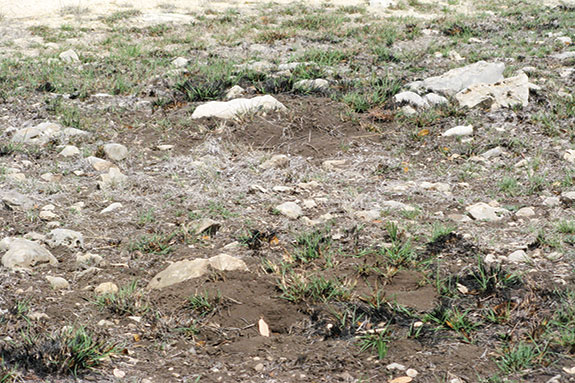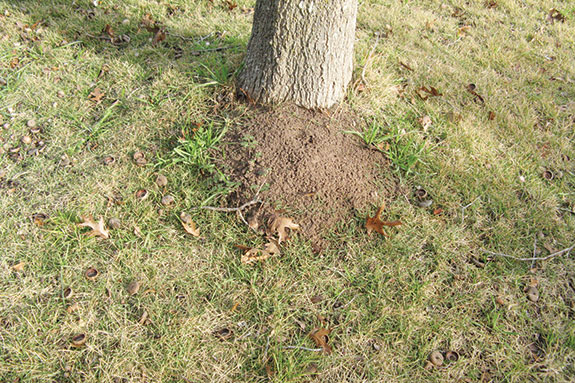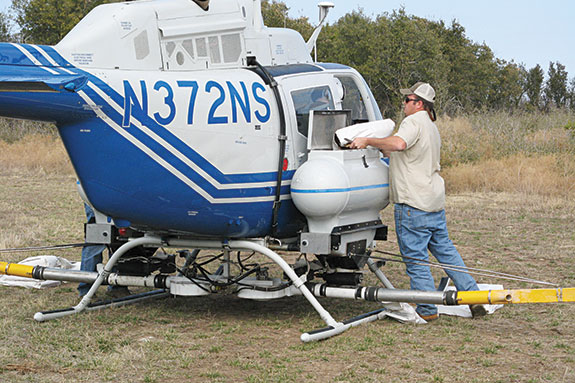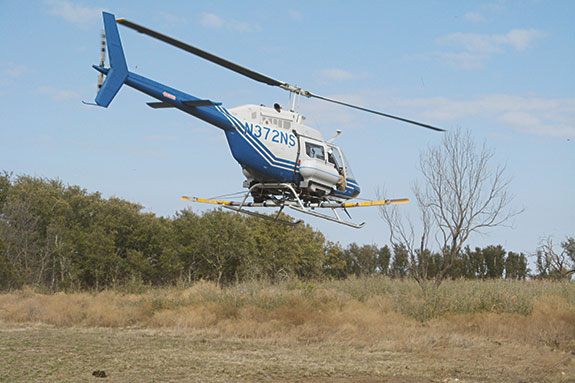As of November 2012, imported fire ants inhabit all or parts of Alabama, Arkansas, California, Florida, Georgia, Louisiana, Missouri, Mississippi, New Mexico, North Carolina, Oklahoma, Puerto Rico, South Carolina, Tennessee, Texas and Virginia.
Large mounds created by fire ants damage pickups, all-terrain vehicles (ATVs), shredders and hay equipment.
Mounds cause horses to fall and riders to take bad spills. Other negative fire ant impacts include injury and loss to livestock and wildlife, infested feed and damaged electrical/telephone equipment.
Carrying capacity of the ranch is reduced because cattle will not graze in and around fire ant mounds.

“Fire ants are an economic problem for ranchers, but an emotional issue for homeowners,” says Dr. Paul Nester, extension program specialist – IPM, Texas A&M AgriLife Extension Service.
“Producers have to determine how fire ant infestations will affect the bottom line while homeowners worry about the ants stinging family members and guests and the unsightly appearance of mounds on the front lawn.”
Treat or not treat
Effective fire ant control requires a programmed approach, and pretreatment planning is an essential part. Annual economical losses caused by fire ants need to be calculated and compared with treatment costs.
The cost of eliminating fire ants from an entire operation may not be justified by economic losses, particularly on large ranches. In this case, the better option is to identify and treat those areas only where control costs are justified.
“To control costs, fire ant management may be confined to high-traffic work areas, feedlots, hayfields and calving pastures,” says Nester. “Treatments can be limited in lesser work areas, infrequent traffic locations and in the back pastures.”
“Create a rough map of your cattle operation or use an aerial photograph,” recommends Dr. Kathy Flanders, extension entomologist at Auburn University.
“Besides range and pasture, your operations include a number of use sites, such as residences, barns, corrals, hay meadows, farm ponds, orchards and field crops.

“On the map, mark areas where fire ant control is the most important. A typical map might include the following priorities: areas around the ranch house that receive heavy foot traffic or where children play, around electrical circuit boxes, where frequently used farm equipment is parked and any areas where cattle are closely confined.
Priorities may include the most valuable hayfields, hay storage areas and summer calving pastures.”
The next step is to identify fire ant mound locations within the areas designated as important and note the greatest concentrations.
Classify the marked areas according to how quickly you need fire ant control. The information listed on the map will help determine the treatment method and which insecticide to use.
Two-step with fire ants
“One cost-effective and environmentally friendly approach to manage fire ants is called the two-step method,” says Dr. Bastiaan Drees, an extension entomologist at Texas A&M AgriLife Extension Service.
“This approach works best in fully infested areas of 20 or more mounds per acre and where there is little or no concern for preserving native ant species. Two-stepping includes broadcasting a bait insecticide over an entire area in the spring between late April to mid-June and in the fall between late August and mid-October. Remaining individual problem mounds are then treated with an approved drench, granule, bait or dust insecticide.”
“A hand-held seeder or spreader is ideal for broadcast treatments of lawns or other small areas around buildings or equipment,” says Nester.
“A low-volume applicator mounted on a tractor, the receiver hitch of a pickup truck or ATV is suited for pastures, hayfields and range less than 200 acres. For low-traffic areas, there are skip swath techniques for applying insect growth regulator baits. Two acres are covered with only enough bait for one acre by applying the material on every other swath.”
To use ground equipment effectively, pasture and range need to be free of brush, logs, deep gulches and other obstacles.

In most cases, aerial application is more economical than ground equipment on 200-acre-or-larger areas.
North Star VMS developed a fire ant control system that costs approximately $18 to $20 per acre and provides 85 to 90 percent fire ant control.
Retreatment is normally not required for 18 to 24 months.
Considering the longevity of the treatment, this program delivers imported fire ant control for a cost of $6 to $10 per acre per year.
“We apply Extinguish Plus fire ant bait, which provides a two-pronged approach,” explains Barney Lee of North Star VMS. “Extinguish Plus is a blend of one-half methoprene and one-half hydramethylnon (Amdro Pro).”
“Bait products with IGR active ingredients, such as fenoxycarb, methoprene and pyriproxyfen, are slow-acting,” says Nester.
“They provide maximum suppression for about two months from spring or early-summer applications and about six months when baits are applied in late summer or early fall.

This performance profile is the same for individual mound treatments.
“Only IGR baits persist in surviving worker ants to provide residual that prevents queens from producing worker broods for many months.
Because winged female reproductive ants produced in treated colonies are sterile, bait treatments are critical in eradication programs.
Furthermore, the long-lasting effects of IGRs increase intervals between treatments.
The active compound is shared readily among ant colonies in polygyne (multi-queen) communities, allowing for modified treatment patterns such as skip swath applications.”
“Hydramethylnon, the other product in the blend, is an insecticide that eliminates 80 to 90 percent of ant colonies in three to six weeks following broadcast application,” says Lee.
“The insecticide becomes active after the worker ants have carried the IGR to the queen. Extinguish Plus is aerially broadcast at 1.5 pounds per acre and requires precision application equipment to deliver this small amount.”
“Fewer than 20 mounds per acre can be treated individually with contact insecticides,” states Flanders.
“Individual mound treatments, the second step in the two-step program, are generally considered the most labor-intensive and costly treatment methods and they give the shortest fire ant-free period. However, fast-acting methods are the most desirable in some situations, especially where preservation of native ant species such as red harvester ants and other competitor ant species is desired.”
Some products such as those containing carbaryl, pyrethrins, pyrethroids or d-limonene can provide almost immediate control when and where necessary.
Check the pesticide label to ensure the product is registered for pasture use.
“Although there are many available fire ant bait products, only specific ones such as Extinguish Plus, Extinguish and Amdro Pro and Esteem can be applied around animals used for food production,” says Nester. “Amdro Pro should not be confused with Amdro when making pasture applications.”
Under favorable conditions, fire ant colonies multiply rapidly and can eventually engulf the entire ranch. When they appear, it is important to initiate a control program that fits ranch operations.
More information is available click here to view. ![]()
Robert Fears is a freelance writer based in Texas.
PHOTOS
PHOTO 1: The imported fire ant.Courtesy of University of Florida.
PHOTO 2: Fire ant mounds on a central Texas exotic game ranch.
PHOTO 3: Large mounds created by fire ants damage equipment, livestock and pasture, causing injury to livestock.
PHOTO 4: Filling hopper on helicopter with fire ant bait.
PHOTO 5: North Star Helicopter broadcasting fire ant bait on central Texas beef cattle ranch. Photos courtesy of Robert Fears.






